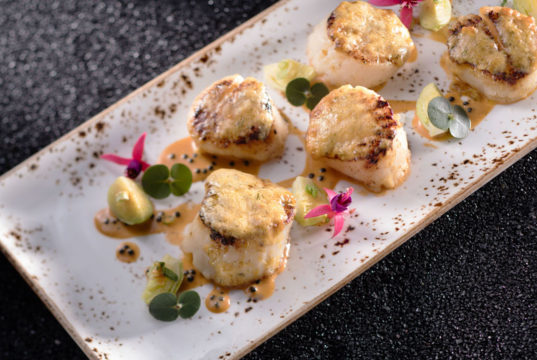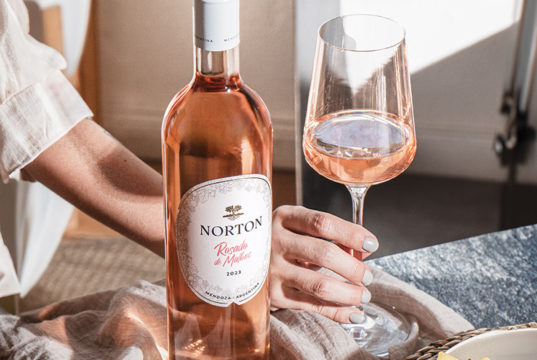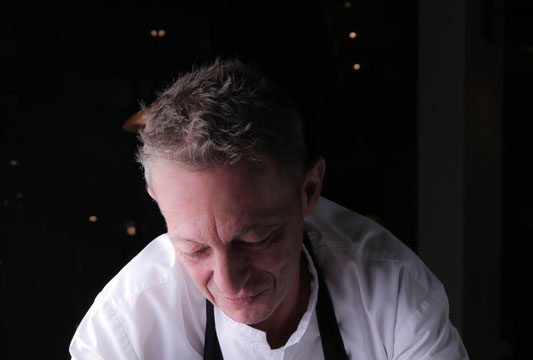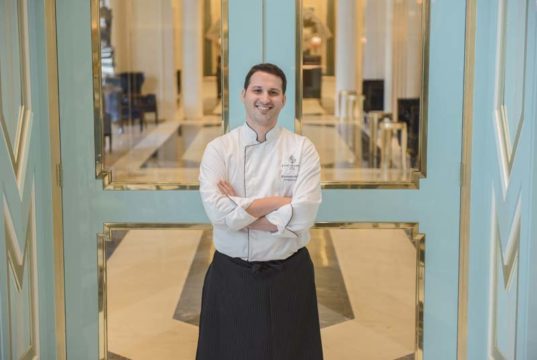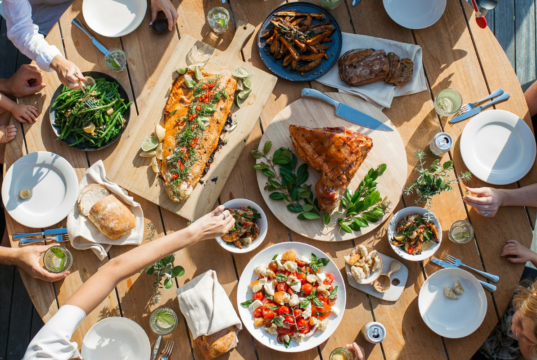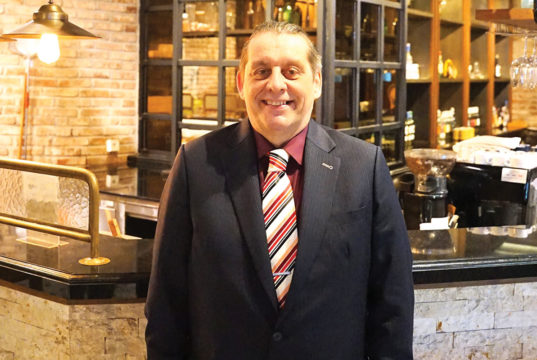The Secret is out
As the partner and head bartender of Singapore’s revolutionary 28 HongKong Street, Michael Callahan has never been shy of a challenge. The Hawaiian-born cocktail maestro left the high-flying big city lights of San Francisco and New York to take on the unexplored cocktail territory of Singapore. Armed with a killer cocktail repertoire and a concept never before seen on the island city-state, Callahan’s 28 HongKong Street cocktail hotspot has grown to become one of Singapore’s most influential bars.
Where most world-famous watering holes ensure their names remain on the lips of thirsty connoisseurs with publicity and advertising campaigns, 28 HongKong Street relies solely on word-of-mouth. On top of this, there is no name above its door nor a shred of information to suggest that inside lies an award-winning, world-class cocktail bar. And yet, 28 HongKong Street has earned itself an international reputation and guests scrambling for a reservation to taste Callahan’s craft. We talk to the man himself about his experience in the world of cocktails and this “secret” bar that everyone seems to know about.
Q: 28 HongKong Street has now reached cult status within the Singapore cocktail scene, but it launched without a whisper of PR fanfare and was dubbed a “secret bar.” Can you tell us a little bit about this unique concept?
A: 28 HongKong Street was never intended to be a secret. There is certainly a place in the market for the whole ‘find me if you can’ type of bar programmes, but really, what we were doing was purposely not advertising so that word-of-mouth would grow the bar organically. We weren’t a hidden bar as such, we were just quietly and slowly allowing our roots to grow. Oftentimes, marketing that is too overt can create bars that are misunderstood. The messaging can be confused and guests arrive with preconceived notions. Instead, we wanted you to hear about us from a friend, and because friends tend to respect their friends’ opinions, we hoped guests would come with more of an open mind, interested to experience and discover us as opposed to coming to judge us. And that word-of-mouth actually works a little too well! We just exploded and after the first six months to a year, we were jokingly referred to as “the secret bar that everybody knows about.”
Q: People have really taken to the bar’s concept and it is often hailed as the coolest bar in Singapore. How would you describe 28 HongKong Street and what is your own personal philosophy surrounding it?
A: We shoot for a very high quality – we not only want to become the best bar in the neighbourhood, we aim to be one of the best in the world. 28 HongKong Street was built to encompass all of these great bars, capturing every aspect that makes them so amazing. From Munich to Mumbai, myself and my partners have visited them all and we put all of our favourite components from each one into 28 HongKong Street. We have distilled these world-class features into one place that is cohesive, unpretentious, approachable and fun – one that encompasses everything that is great in the cocktail scene right now. We often hear our guests say, “Wow, I feel like I’m in Tokyo” or, “Wow, I feel like I’m in Melbourne”, and that’s exactly what we want to hear. With no windows and with doors hidden behind curtains, you could be anywhere in the world, at any time, in any era. 28 HongKong Street is meant to be timeless; it allows you to make it whatever you want it to be. I have to credit my partners and my staff for building this environment that is super welcoming and world-class without ever waiving quality and experience.
Q: 28 HongKong Street is praised for many things, but the innovative cocktails have really kept people talking. How and where do you find inspiration for these ingenious mixes?
A: Everywhere and within everything. It’s never-ending. As a photographer or an artist, you might see something that suddenly inspires you and you can’t get that image out of your head – I’m the same with cocktails. I even read about places I’ve never been to and I’ll try to imagine what that place would be like. For example, for a cocktail I created recently to match a Spanish-Portuguese food programme, I pictured someone fishing off of the coast of Portugal. I thought, if this fisherman takes a break and wants a nice cocktail, what would he want and what would be fitting to the environment? I try to mentally project the whole experience, enveloping all of the emotions until I find a recipe that fits. On the other hand, my inspiration might be as simple as remembering a flavour that I had as a kid. But there is no stopping what can inspire making a good cocktail – it’s the world around you and it’s always happening.
Travelling the world has also had a huge influence. It has let me experience new flavours and new techniques. I used to travel back and forth across the U.S. as much as I could but I soon realised how much more was out there. I went to Japan to watch the style of Japanese bartenders. I went to New Zealand and Australia to see how they integrate that cheeky campiness with a molecular flair. In Europe I got to experience and learn from the top bartenders in London. Every trip and every experience has helped to build and expand my skill set, adding cultural, nostalgic influences to my own style. Once you get a taste of that, how do you stop?

Q: You also have some really cool and playful names for your cocktails. How do you come up with them?
A: Naming cocktails is by far my favourite part of developing a cocktail menu. In my eyes, a cocktail name should have a few different components. Firstly, it should be memorable – something that quickly catches your attention in just one, two or three words. Secondly, within that catchy name, it needs to paint a picture of where you’re going with that cocktail – a descriptor of where the cocktail will take you or where it hails from. For example, one of my favourite cocktails at 28 HongKong Street is “Hard to Port.” Hard to Port is a nautical term that normally means to turn to the left. Indeed, this is a very left field cocktail, but the naval reference refers to the Porter Beer that is used in the cocktail, which is very popular with London dock workers. It emulates a beer cocktail, but actually, it also uses a rye whiskey as well. So, the whiskey makes it a bit of a hard cocktail, but it is acting as a Porter beer, hence “Hard to Port.” There are even more layers and meanings in that too with varying levels of associations with the words, ingredients and history, but it’s important that it is still easy to say and that it remains kind of catchy, and I think Hard to Port does that.
Q: So what’s your all-time favourite drink?
A: A Boulevardier cocktail for sure. Imagine a Negroni, but instead of using gin, a Boulevardier uses whiskey. You still get the brightness of the Campari and the anchor of the Sweet Vermouth, but on top of that you also get a full and rounded body from the whisky which ties everything together. I like a balanced drink that I can drink whenever – with dinner, as an aperitif, or by itself. A Boulevardier gives me that. It is classic, timeless, well balanced and something I can drink all day long.
Q: You’ve recently become involved in cocktail consulting in Bali. How does Bali differ to Singapore in terms of the cocktail market?
A: One of the most obvious differences is that Bali has some supply issues. But they excel in other areas like staff ability and staff passion. Bali is all about F&B and the locals are so enthusiastic about it. Singapore, however, is similar to the U.S. in the sense that F&B is not exactly seen as a field your parents want you to go into, so it’s difficult to get people into the industry. So in that regard, Bali is actually better poised to catch up and surpass some of the other regions, but at the moment language barriers are making it difficult to elevate the local community to that next level.
Saying that, both markets have had a lack of dedicated consultants until very recently – the kind of consultants who actually move there and really invest their time, love and passion into the community, the kind of mentors that are dedicated to long term training and seeing the success happen right to the end. It is beginning to happen in Bali with people like Dre Masso at Potato Head. He’s a world-class bartender and he is dedicated to making a programme work, and that is what Bali needs more of. Singapore is just about nailing it now. In the last year we’ve had some great bartenders move over and you can 100% see how that has influenced the local staff. The training they have received, the experience they have had – a lot of them are suddenly running out and opening their own bars because they have had that year of solid mentorship. If you have the tools of mentorship available, your market will expand dramatically.
Q: As a mentor yourself, what is your key focus when training bar staff?
A: 100% hospitality. Anyone can make a drink at home by looking up online recipes, but you spend your hard earned money at a bar because you want to be taken care of. Whether you are out to relax, celebrate or to be transported away from your normal life, you go to a bar to experience. So for me, a great barman must focus first and foremost on hospitality. A great barman is not someone who has all the tools to wow you with foams, fogs and airs. Instead, the greatest barmen in the world are masters of hospitality first, then masters of the craft second. In fact, there’s a joke in the industry that says, “What’s the difference between a bartender and a mixologist?” The answer to that is: 20 dollars, 20 minutes and a drink you don’t want. Why? Because a mixologist will talk you into a drink you’re unsure of, it will take half an hour to get it, and it will cost you way too much money for what it is. A bartender on the other hand will take the time to make you exactly what you want, at a fair price and get it to you quickly, because all you want to do it enjoy yourself. I call it a “hospitalitologist”! Practice the art and science of hospitality first, then bartending second.
………………………………………………………………………….
WHITE RABBIT PUNCH Makes about 6 litres
This is one killer ultra-classic cocktail that has been retrofitted to really excel in the current market
TO PREPARE :
• 1.5l Rowan’s Creek Bourbon
• 1.5l tea mix (2 parts caramel Puerh; 2 parts blood orange Puerh; 1 part Lapsang Souchong)
• 2l whole milk
• 300ml Becherovka
• 450ml simple syrup
• 240ml lemon juiceTO MIX:
1. Heat the milk in a large saucepan until boiling.
2. Add the boiling milk to all the other ingredients.
3. Let the mixture sit for 5 minutes; it will start to curdle.
4. Strain the mix through a fine strainer, then refrigerate it over night.
5. The next day, run the mixture through a cheese cloth to get out the fine particles. Now the punch should be almost clear.
6. Bottle it and let it rest in the fridge for at least another 3 to 4 days to improve the flavour. It can stay refrigerated for months and the flavours will continue to improve.
TO SERVE:
1. Serve over a large, hand-cut clear ice cube and garnish with White Rabbit candy.2. Hand picked basil, rosemary and kaffir leaves (from Potato Head’s herb garden) shaken with Cuervo Tradicional Tequila and pressed lime.








